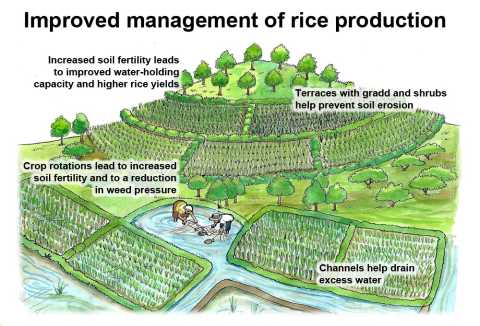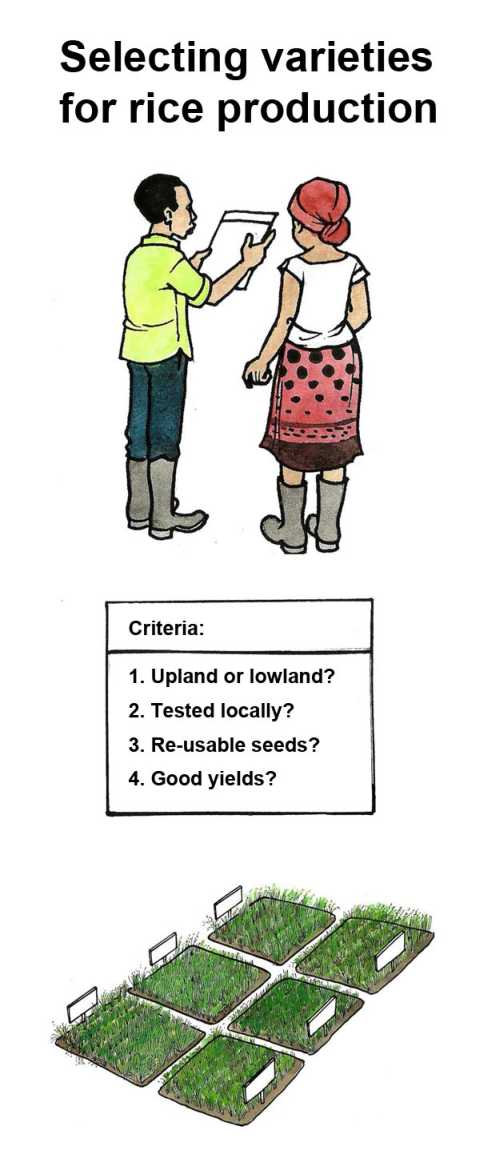Improving access to good quality seeds

In order to increase access to good quality seeds, it is important to first ensure that farmers select varieties suitable and adapted to local conditions. Secondly, farmers should be able to select the seeds from these varieties for the next crop. Lastly the seeds should be properly stored and carefully handled during the seedling production process.
Selection of good rice varieties and seeds

Selection of appropriate rice varieties for a given location is very critical, because it will affect eventual yields. Although varieties can be selected based on many parameters (e.g. yield potential, weed competitiveness, disease resistance, height and lodging resistance), farmers should look out for some key parameters.
Recommendations to farmers for selecting good varieties:
- The first consideration is to decide whether to grow upland or lowland rice, and this will be determined by the type of land available (upland or lowland with available water).
- Then consider either locally adapted traditional or improved varieties which have been tested under local conditions by other farmers or research stations. It will then be clear if the variety’s growing period, weed tolerance, moisture and nutrient requirements are adaptable to local climatic stresses. It is also important to consider varieties that are in high demand on the market and varieties that are preferred by locals because they are easy to cook and because of other local cuisine preferences.
- It is also important to select varieties whose seeds can be selected, multiplied and re-used for the next crop. If completely new seeds are brought from another area, they should be tried and tested under local conditions before scaling up. When possible, select at least four varieties to create the genetic diversity necessary to satisfy different needs.
A good example of new upland and lowland rice varieties is the New Rice for Africa (NERICA) varieties. They combine the high yields from the Asian rice, Oryza sativa, with the ability of the African rice, Oryza glaberrima, to thrive in harsh environments and have a shorter growing period compared to the traditional varieties.
Hybrid and genetically modified seeds are not recommended for organic production, especially among small-holder farmers in Africa.
Since rice is self-pollinating, farmers can select their own seeds directly from the field. However, it is advisable to carefully select seeds to ensure healthy plants and to avoid mixing of varieties. Planting seeds of poor quality will lead to poor germination and transmission of diseases.
Recommendations to farmers for good seed selection:
Select healthy and superior plants (true-to-type) of that variety for seed to make sure that only the best seeds which are well adapted under local conditions are used.
- Before the final harvest, select that part of the farm where the plants are uniform, healthy, and disease-free with productive panicles.
- At full maturity, harvest the panicles and allow them to dry under cool environment until the moisture content of the grain reaches about 14 to 15 %. Do not thresh with a machine, as the seeds could be contaminated with other varieties.
- From the harvested seeds, set aside between 30 to 40 kilos to plant one hectare. The dry season harvest is usually a better source of good seed because it has reached full maturity and, therefore, viability of seeds is longer than seeds harvested during the wet season.
- Store the seeds in a cool, dry place in an airtight container like a pot or hang in the house to deter rodents and other pests. Sometimes pest repelling materials may be added to keep away storage pests. For example, by mixing dried and crushed neem, castor leaves or any locally available herbal repellants.
Determining the seed viability

Seeds for planting should be properly, prepared, particularly for transplanted rice. A higher germination percentage is required in order to achieve the proper number of plants in the field. The ability of the selected seeds to germinate will depend on their viability. Seeds of high viability avoid wastage of time and the farmer is able to plan properly for the quantity required.
Recommendations to farmers for testing seed viability:
To test for viability, count 100 seeds of the rice variety, put the seeds in water, ensuring that all the seeds are covered with water. Allow the seeds to be in the water for 24 hours, thereafter removing the seeds and wrapping then in a moist paper or cloth, then incubate for 2 days. Count the number of seeds that have germinated after the incubation, and express it as a percentage. For example, if out of the 100 seeds selected, 70 out of the 100 seeds germinated, then the germination percentage is 70.
Seeds coming from 3 months or more of storage time need to be prepared by warming in the sun for about 3 hours. Allow them to cool off before soaking; seeds warmed in the morning may be soaked late in the afternoon or seeds warmed in the afternoon may be soaked in the evening or early the next day. Soak for 1 to 1.5 days and remove the seeds that float and use only seeds that sink. Then incubate the seeds to quicken germination. Start incubation in the morning, to take advantage of the sunlight that hastens rapid germination. Fill sacks just about half full, tie or close them tightly during the first day and place them under the sun and cover with sacks, plastics or rice straw. Check in the afternoon, loosen the sacks and mix the seeds if the heat is too much. Pile the sacks on top of each other, but reduce the cover. Repeat checking and mixing on the next day (second day of incubation).
The farmer can sow pre-germinated seeds to avoid the uncertainty of the seeds not germinating. Pre-germinated seeds can be prepared as described for the germination test, but should be incubated for 36 hours instead of the 24 hours. However, sowing pre-germinated seeds is recommended when rainfall is imminent within the next day, to avoid damage by birds and rodents.
Finally, prepare a seedbed 60 to 80 cm wide, with a height of 3 cm from the ground. This will be easier to prepare and easy to manage during sowing and taking care of the seedlings. Level the beds in order to produce a uniform growth of seedlings. Make a bed for each variety separately and label the beds with the variety name. Water regularly and protect from direct sunshine.
NOTE: The method of raising rice seedlings, described above, is widely used in irrigated lowland systems. In rainfed upland or lowland systems, planting is done directly in the prepared fields’ drilled rows, hills or by broadcasting. Dibbling, planting in drills and hills is preferable to broadcasting, in order to ensure optimum plant population and to aid subsequent field activities. Straight row planting can be achieved by using a planting rope or rake, at a spacing of about 30 cm between rows.
Source: FiBL


Comments
Post a Comment